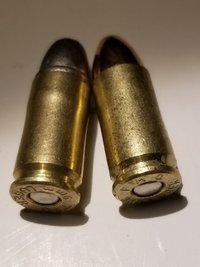Hey guys.. I have about 5000 bullets cast with a six gang .356 TL Lee mold that are bulging the brass. I've never had this happen with bullets purchased from Better Bullets, Rim Rock or Bayou Bullets or in any of the plated bullets ive tried from Berry's, FMP, or XTreme.
The calipers tells me my cast bullets measure .359 and some 124 gr plated I have. (I think XTreme) measure .356. Does this simply mean i have to buy a Lee sizing die to push 5000 bullets thru or am i missing something. Is there that much variation in a .356 TL mold or does it have something to do with the properties of the lead i'm using. Can a bullet expand aftet being released from the mold? I included a picture but its probably not needed. Thanks a lot but i cant imagine i won't be ordering a die and single stage press tomorrow.

The calipers tells me my cast bullets measure .359 and some 124 gr plated I have. (I think XTreme) measure .356. Does this simply mean i have to buy a Lee sizing die to push 5000 bullets thru or am i missing something. Is there that much variation in a .356 TL mold or does it have something to do with the properties of the lead i'm using. Can a bullet expand aftet being released from the mold? I included a picture but its probably not needed. Thanks a lot but i cant imagine i won't be ordering a die and single stage press tomorrow.

